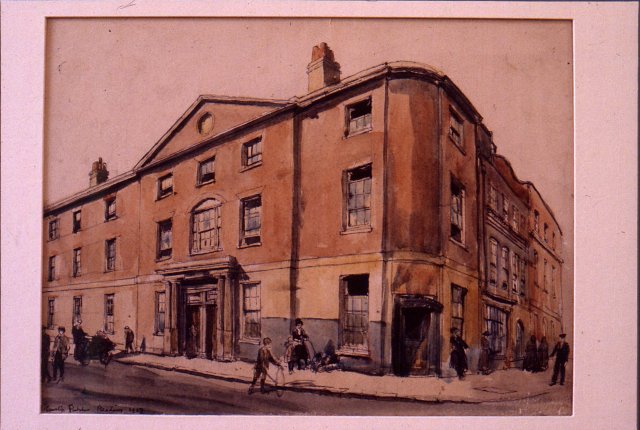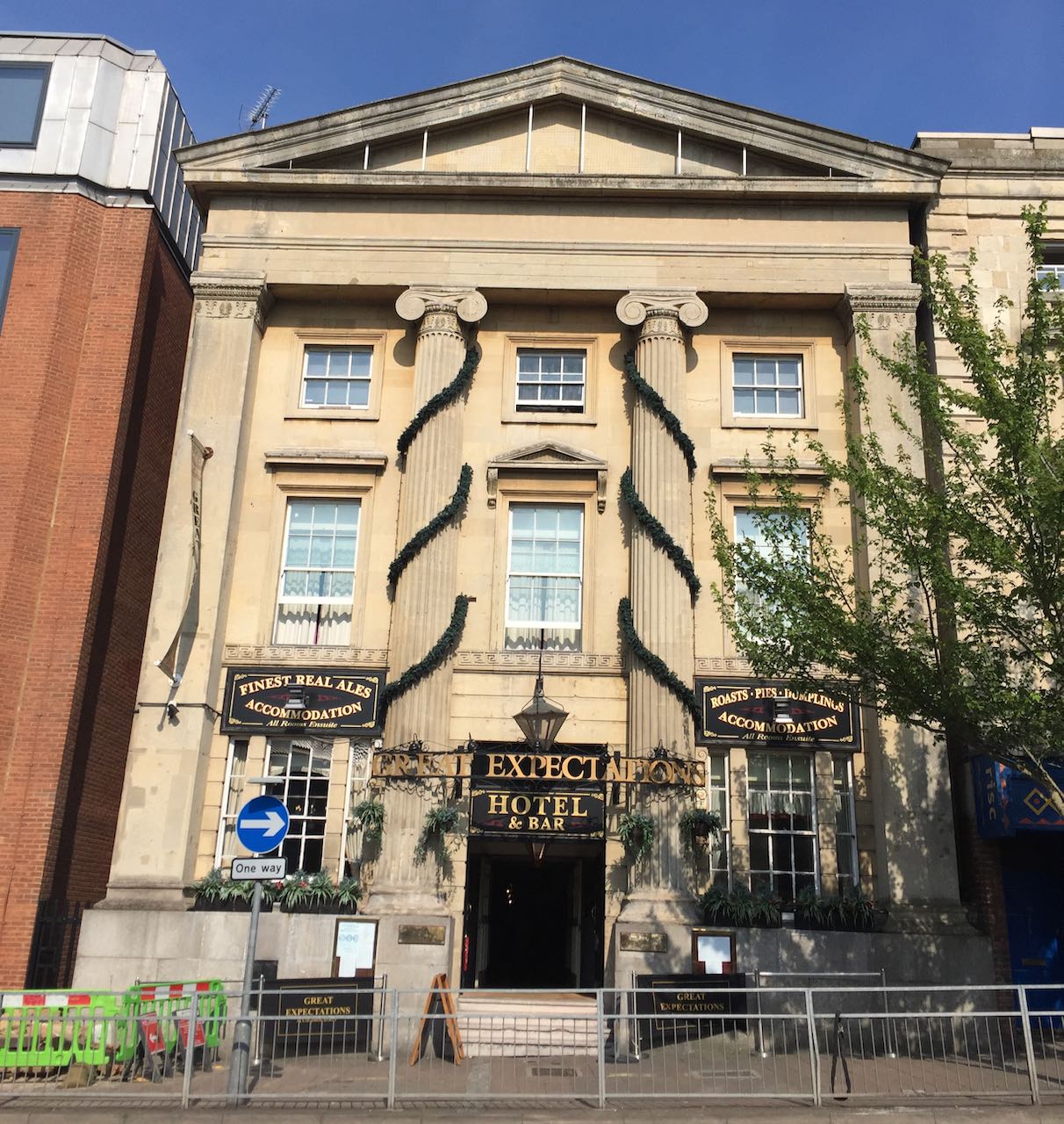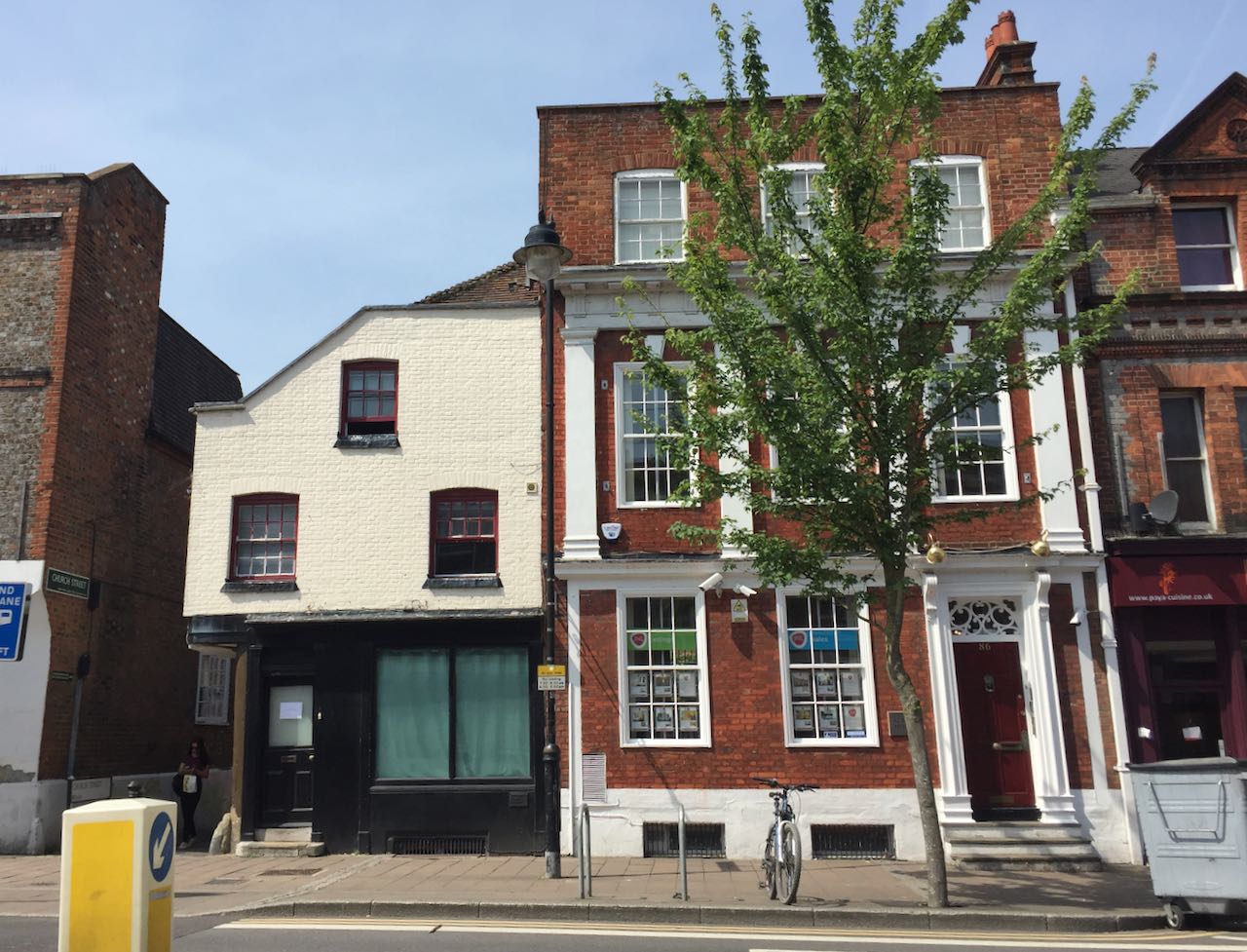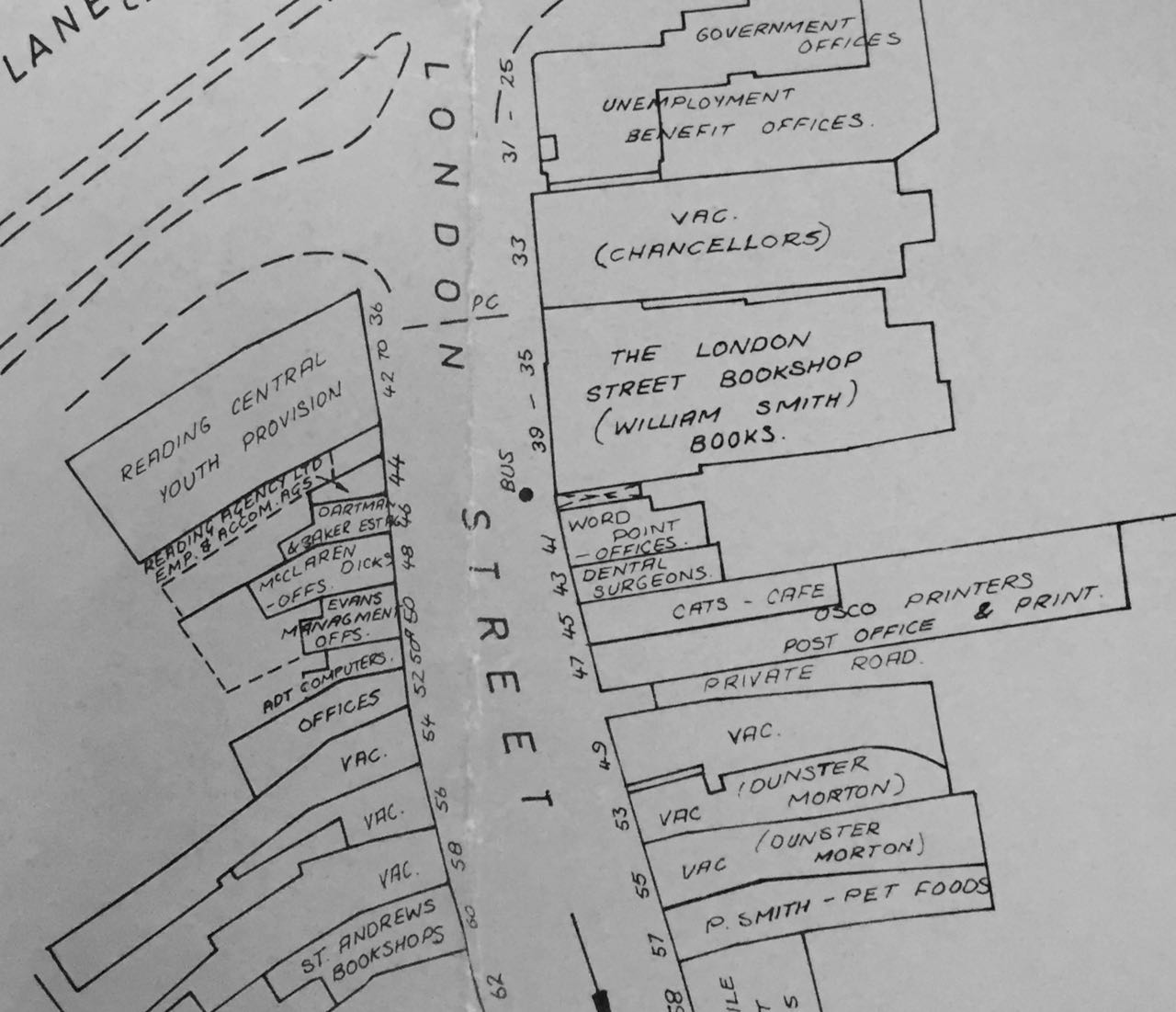In the second of our Time Travel on London Street blogs, following part one, we look at the wider view of London Street from the sixteenth century to present.
The sixteenth and seventeenth centuries
49-53 London Street is an altered sixteenth century timber framed building which probably existed at the time of Amyce’s survey when the property was owned by the St Giles churchwardens. Harman says that these were built by the parish and known as ‘New Rents’. Behind these properties three or four more small houses were built[1].
No. 88 at the corner with Church Street also originally dates from the sixteenth or seventeenth century and in 1552 a property on this site was owned by William Grey.
Siege defences built by the royalist governor of Reading in 1643 during the English Civil War lay to the east of London Street approximately where East Street is today. Townspeople living on London Street would have been affected by the damage to Reading’s economy caused by the siege.
The eighteenth and nineteenth centuries
London Street is characterised by buildings largely dating from the mid-eighteenth to the mid-nineteenth century. At this time it was a busy and fashionable street. In 1788, High Bridge was built over the Kennet. The architect was Robert Brettingham of Hanover Square in London. It is a Scheduled Ancient Monument and an impressive route to and from London Street.

Old Crown Inn, Reading, Watercolour by Hanslip Fletcher 1917. REDMG : 1931.109.1 (c) Reading Borough Council, Reading Museum
At the top of London Street on the corner with Crown Street was the Crown, a historic inn first mentioned in 1518[2]. It became one of the most important coaching inns in Reading. Coaches stopped there to pick up and drop off passengers and for refreshments. It was demolished in the 1960s.
The coaching trade to the Crown was a major contributory factor to the early success of Joseph Huntley’s bakery business set up in 1822 at nos. 119 and 121 (which became the famous Huntley & Palmers biscuit company).
Over the road was an ironmonger’s shop where Joseph Huntley junior was an apprentice. In 1832 he set up his own business that grew to be Huntley, Boorne & Stevens tin works.
London Street in 1842 had a significant number of residents who like Joseph Huntley junior made things. They included a bonnet maker, a shoemaker, an umbrella maker, a cabinet maker and a tailor. These businesses sat alongside bakers and confectioners who sold from their shops as well as booksellers, drapers, grocers and wine merchants dealing in goods. There were also solicitors, estate agents and educational institutions[3].
Mary Mitford ceremonially laid the cornerstone of the public rooms on London Street on 31 August 1842. The Berkshire Chronicle reported “..from the rather unusual circumstances that a lady (Miss Mitford the well known authoress) had consented to officiate, much interest was taken in the affair.[4]”

Great Expectations, originally the new public rooms. Evelyn Williams.
The opening of the new public rooms and the Literary, Scientific and Mechanic’s Institute was a significant civic and cultural event and the Reading Mercury report covered six and a half columns of tiny typescript in its 28 October 1843 edition. The hall of the Institute was laid out with four rows of benches for a formal dinner followed by speeches, multiple toasts and musical interludes.
Charles Dickens had been invited and although unable to attend had written wishing the building every success “...with much pleasure in knowing that my friend Mr Serjeant Talfourd [Thomas Talfourd] will be present at its christening, as the representative of literature, and the champion of its rights.”
Reading born Talfourd spoke positively of the development of the town “...if that great benefactor of Reading, Mr Edward Simeon, could ascend the column with which he decorated the Market Place, he would be enabled to find but few traces of Old Reading.” He continued describing how “...sequestered dells, and lanes and fields, were now the sites of glittering streets and terraces.” He mentioned Oxford Road once known as Pangbourne Lane “...because, to their minds, Oxford was then a thing beyond all conception... .”
After a mention of the “noble institution” of the Royal Berkshire Hospital he was able to turn south towards Silver Street and provoked some amusement when he said that the street “...still preserved some of its ancient qualities... .” His virtual journey continued south to Whitley and onwards to Three Mile Cross that had become the property of all mankind as ‘Our Village’; a compliment to his friend the author Mary Mitford.
The architect for the Public Rooms was W. Brown and he spoke later in the evening in words which might still resonate with architects today “It unfortunately but too frequently happened that the ideas of an architect were thwarted or crippled by committees, but he could, with confidence, say that no one ever had the good fortune to meet with a body more anxious to smooth his path and forward his views... .[5]”
After a dramatic beginning the Institute became a Primitive Methodist Chapel in 1866 and was to have many future uses including as the Everyman Theatre, and the Great Expectations pub and hotel.
Reading’s road system expanded in 1830 when Queens Road was built east from London Street. In the mid-nineteenth century Royal Passage and a house were demolished so that South Street could be extended to join London Street.

88 & 86 London Street. Evelyn Williams
Thankfully, a proposal by members of the council to widen Church Street in 1878 by knocking down what Mr Colebrook referred to as 'The old house at the corner [probably no. 88]...' was not pursued due to other financial priorities. Mr Colebrook who became mayor of Reading in 1880 lived at no. 78.
Mr Gilligan opposed it saying that 'Church Street was not a place for public traffic. If the large tin manufacturing firm [Huntley, Boorne & Stevens] on the one hand and the Society of Friends on the other desired it, it seemed the proper thing to him that they should pay for it.'
Things could have been worse if Alderman Andrewes had had his way as he felt that the improvement should go right through to Horn Street (Southampton Street) and that the proposal did not go far enough[6].
One of the sites along London Street that has been redeveloped is no. 63 and 65 at the northern corner of South Street which were Burberry’s first premises in Reading. Thomas Burberry took over the shop and stock of John Allright in 1889.
The twentieth century
In 1903, when Reading council compiled a survey of licensed premises, there were nine alehouses or beerhouses and an off-licence on London Street and the street was described as a 'business street, residents being engaged in trade and residing over their shops[7].' During the twentieth century this changed so that by 1969 when the council set out to consult on the route the Inner Distribution Road (IDR) would take at the foot of London Street they expressed concerns.
In the booklet that was produced to inform Reading people about the plans they said 'As well as shops there are offices and factories, hostels and workshops and, most important, many people still live there. But more use needs to be made of floors above shops where they are no longer used as homes. Every effort should be made to retain as many residential premises as possible as having people living in the area is the best way to keep it alive and busy.'
The proposed option, an elevated roundabout at the foot of London Street, was designed to do least harm and '...if possible ways should be found to make this road help London Street to prosper.'
The document continued 'Fine old buildings crumble and decay unless they are looked after. This costs money. ... Thus it is no good thinking of London Street as a museum piece.' It then looked forward to the use of ‘special powers’, those of the Civic Amenities Act 1967, to make London Street a conservation area[8].
The plans did not come to fruition and during the 1980s the loop of the IDR was completed by widening existing streets. However it is still felt today that the IDR damaged trade on London Street by breaking the link with the town centre. Traders at that time would also point to the 1969 one-way system which they claimed would reduce business by a third[9].
The IDR necessitated the demolition of properties on both sides of London Street and exposed the north wall of the Central Club (Reading Central Youth Provision), formerly the Police Garage. This provided a perfect canvas for the 1990 Black History Mural project led by artist Alan Howard and executed by members of the Central Club and wider community.

The Central Club and Black History Mural. Evelyn Williams.
The Market Place/London Street Conservation Area was first designated in 1972. Kelly’s Directory for that year includes antique dealers, an artist, an artists’ materials shop, a baker, a betting shop, a bingo hall, bookshops, a butcher, cafes, a dentist, a doctors, a department store, estate agents, a florist, a fruiterer, hairdressers, a hostel, insurance brokers, a locksmith, a newsagent, a pawn broker, solicitors among others. A few properties were empty and others may have been purely residential.
The massive factory of Huntley, Boorne & Stevens with offices at the top of London Street had closed and moved to Woodley at the end of the 1960s. After a century of growth and expansion on the site, this represented a significant change in the character of the street.
The Goad map for 1986 showing the northern portion of London Street has a large number of empty properties. 35-39 London Street would also be empty in a few years.

Extract from Goad map 1986 showing northern section of London Street
Today
Today, this Katesgrove street has many entirely residential properties but at street level some businesses and professional firms still operate with apartments above. There is a barber, beauty parlours, a bookshop, a cafe, a casino, charities, a doctor, educational institutions, estate agents, one hotel and public house, a night club, a recruitment agency, restaurants, solicitors, student accommodation and a supermarket.
London Street remains an important route to and from Reading for road traffic and pedestrians.
In recent years, a few independent restaurants had opened on London Street which, together with the well-established Global Cafe at RISC, had added an extra dimension to the street. The South Street Arts Centre had been saved from threatened closure with a reputation that was going from strength to strength.
There were challenges to life on the street as we knew it too. The After Dark Club, which has been a community venue for over 200 years, lost its licence and the Shehnai wedding and conference venue at The Olympia Ballroom closed its doors.
Amidst the current restrictions imposed by living with COVID-19, an extra layer of uncertainty has been added to planning the future of our conservation area.
Related objects in Reading Museum
Many objects throughout the Museum relate to the history of London Street and its people.
The Story of Reading gallery
In the centrepiece case:
-
Huntley & Palmers biscuit tin made at Huntley, Boorne & Stevens factory with an artist's impression of the shop on London Street.
In the nineteenth century display cases:
- A portrait of George Lovejoy and a miniature of his first wife Martha Wilkinson.
- A portrait of the author Mary Mitford.
- A description of the social scene in Reading in the eighteenth century is accompanied by an illustration of the new public rooms occupied by the Literary, Scientific and Mechanic's Institution (now the Great Expectations pub) which opened in October 1843.
- A list of the products from the original shop of 'Wholesale Baker and Confectioner' Thomas Huntley, at 72 London Street.
- The enamel Board of Trade sign for the Labour Exchange at 29-31 London Street which operated from 1913 and moved to South Street in 1933 (now demolished).
In the twentieth century display cases:
- Huntley, Boorne & Stevens recruitment brochure from the late 1940s attracting women to work at the factory with the title Your Job in Reading and Happiness in Industry.
In the Huntley & Palmers Gallery on the first floor are many more biscuit tins and Huntley & Palmers artefacts.
This blog was written by Evelyn Williams of the Reading Conservation Area Advisory Committee. To view more images from Reading's history visit Reading Museum's Online Collections or Reading Library's Online Catalogue.
End Notes
[1] Harman, Leslie (1946) based on 1552 survey of Roger Amyce and Sydney Peyton’s 1919 map. The Parish of S Giles in Reading, The Vicar and Parochial Church Council.
[2] Dearing, John (2009). Reading Pubs, The History Press.
[3] Post Office Directory 1842.
[4] Berkshire Chronicle, 3 September 1842 p3.
[5] Reading Mercury 28 October 1843.
[6] Reading Mercury 3 August 1878, p6 reporting on the Reading Town Council Survey and Finance Committees.
[7] County Borough Of Reading (1903). Licensed Houses : REPORTS of the committee of borough justices appointed to visit Licensed houses to obtain Statistical Information, and of the Clerk to the Justices, and Statistical Information obtained, John Read Printing Works.
[8] Reading Council (1969). Reading London Street and the IDR.
[9] Evening Post 11 January 1969 p2. The battle of London Street.





